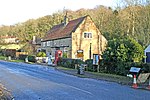Grimstone, North Yorkshire
Civil parishes in North YorkshireRyedaleUse British English from June 2023Villages in North Yorkshire

Grimstone or Grimston is a hamlet and civil parish in North Yorkshire, England. It lies beside the main B1363 road between York and Helmsley. Grimston lies in the Howardian Hills just south of the North York Moors National Park and close to Ampleforth Abbey and College. In 2015 it had an estimated population of 60.Grimston is small, and is made up of around 14 households. Historically, it originates from an old manorial estate, and several of the buildings still hold related names: Grimston Manor, Grimston Manor Farm, Grimston Lodge, Grimston Cottage and Grimston Grange. Grimston was recorded in the Domesday Book as Grimeston.
Excerpt from the Wikipedia article Grimstone, North Yorkshire (License: CC BY-SA 3.0, Authors, Images).Grimstone, North Yorkshire
Geographical coordinates (GPS) Address Nearby Places Show on map
Geographical coordinates (GPS)
| Latitude | Longitude |
|---|---|
| N 54.17136 ° | E -1.05275 ° |
Address
YO62 4HR , Grimstone
England, United Kingdom
Open on Google Maps









